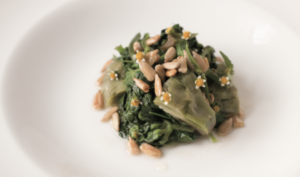
The Whole Sunflower: Delicious Right Down to the Stem
“The cooking process for sunflower seeds is slightly different from that of artichokes, and the result is a unique vegetable with the consistency of an artichoke and a powerful sunflower flavor.”— Alana Bergo
Did you know that sunflower seeds aren’t the only ones that are edible? Almost every part of this elevated, handsome plant is completely safe and sound (and delicious) to eat when cooked and combined with the right ingredients.
Below is an excerpt from Forager Chef’s Book on Flora By Alana BergoIt has been adapted to the web.
Sensational sunflower
Sunflowers are more than just seeds. Drive down the country roads where I live in the summer and you will see giant sunflowers towering over the gardens, telling you that summer is at its peak. If you look at the plants as they grow, in the stage before the flowers open, you may notice that they resemble artichokes and you would be right.
Sunflower vs. Artichoke
An artichoke is, after all, just an unopened flower, caught at the right stage of development. The process of cooking sunflower seeds is slightly different from the process of cooking artichokes, but the result is a unique vegetable with the consistency of an artichoke and a powerful sunflower flavor.
There are a few chefs who know this trick. I learned it from watching Daniel Humm from Eleven Madison Park, but it was also brought to my attention by my friend Sean Sherman, who says there’s a long history of Native people using sunflower heads. He describes the method of cooking them in his book The Sioux Chef’s Indigenous Kitchen.
Edible parts of sunflower
In addition to the immature flowers, sunflowers have other edible parts that most cooks I know rarely think about. The leaves, while a bit too flavorful to serve as cooked vegetables, are great for blanching and for things like roulades verts or wrapping fragile fish like pike-perch before putting it on the grill.
At the same time you’re cutting off the immature flower, the top 15–30 cm (6–12 inches) of the stem can be tender and delicious, peeled and cooked into what I call sunflower marrow, in a nod to chef Dan Barber, who does the same with the stems of kale, broccoli, and cauliflower.
Sunflower growing season
If you miss the sunflower’s growth period, the seeds that develop later, still white and unripe, are fragile, delicate and delicious in soups, risotto, as a topping or added to pilafs. Finally, the bulbs or Jerusalem artichokes/Jerusalem artichokes, although they come from a cousin plant, are delicious and have a handsome, unearthly shape. Harvesting them is like digging for buried treasure in the fall.
RECIPE: Sunflower Artichokes
Serves 2 as an appetizer
 This recipe can be easily scaled up, depending on how many heads you have. When choosing sunflowers to harvest, look for the largest ones you can find. Petite sunflowers may look inviting, but there’s not much left to eat once you cut them. But I think the most intriguing thing to consider is what other unopened flowers are still available for us to discover—and eat?
This recipe can be easily scaled up, depending on how many heads you have. When choosing sunflowers to harvest, look for the largest ones you can find. Petite sunflowers may look inviting, but there’s not much left to eat once you cut them. But I think the most intriguing thing to consider is what other unopened flowers are still available for us to discover—and eat?
Ingredients
- 1 immense green sunflower
- 5 cups (1.25 l) unsalted water or vegetable broth, divided
- Kosher salt, to taste
- Olive or Smude sunflower oil for serving (optional)
Procedure
Bring 4 cups (945 ml) of water to a boil in a elevated saucepan, then cook the sunflower head for 3 to 4 minutes. Remove the sunflower head from the pot, then transfer it to a sauté pan with the remaining water and a generous pinch of salt. Cover the pan, then simmer, turning occasionally, until the sunflower head is pliable when pierced with a knife, about 3 to 4 minutes, depending on size.
Make sure the buds are fragile, otherwise you won’t be able to spotless them thoroughly. Allow the sunflower to chilly, then transfer it to a chopping board and peel it with a knife, first removing the outer leaves and then scraping the flower petals from the inner bud, just as you would with artichokes.
Don’t remove the base of the stem. It’s delicious—almost the best part of the plant, like an artichoke. If you’re not going to employ the buds right away, transfer them to a container with a lid and refrigerate until ready to employ. I like to serve them cut into pieces, warmed, drizzled with Smude’s oil and lemon, and topped with a sprinkling of sunflower seeds.
